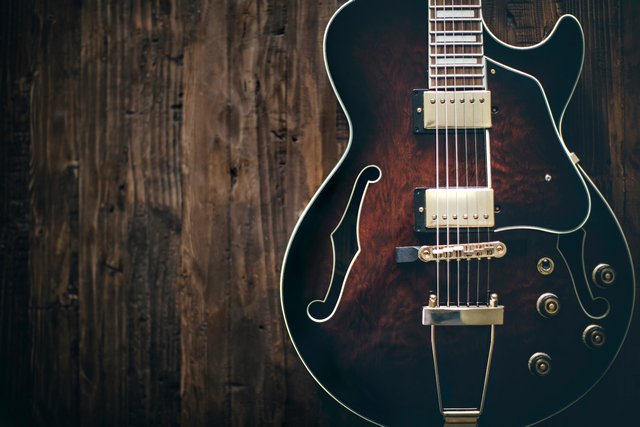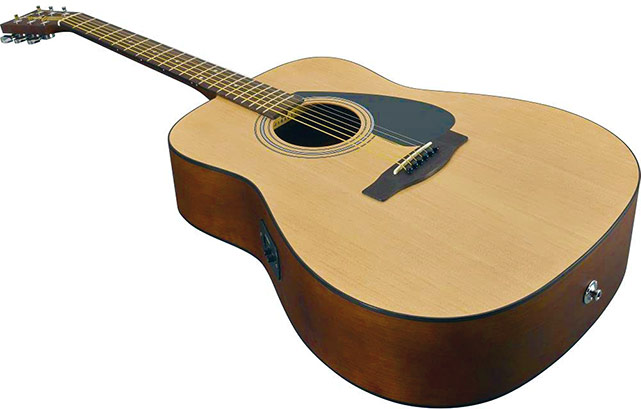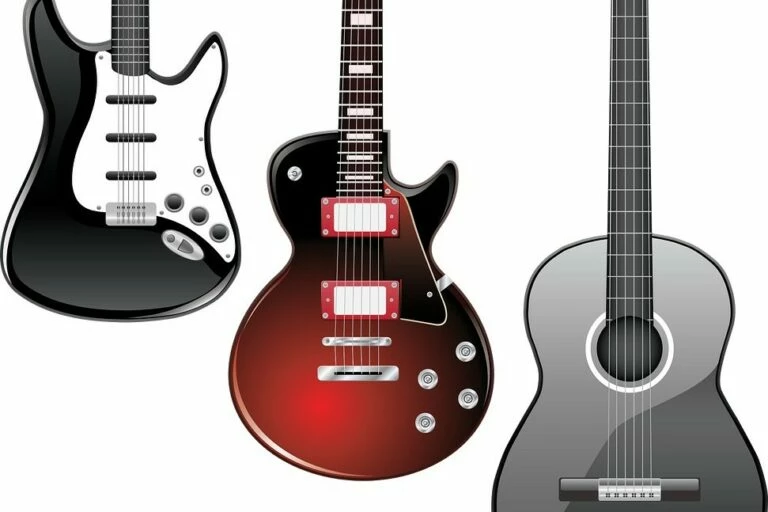It is easy to differentiate between an acoustic and electric guitar; semi-acoustics are also discernible, but what exactly is an acoustic-electric? Aren’t semi-acoustic and acoustic-electric the same thing? Many people make the mistake of thinking they are one and the same.
However, it couldn’t be further from the truth because they are actually very different instruments. This article will closely examine the differences between electric, semi-acoustic, and acoustic-electric guitars. We’ll also be discussing the pros and cons of each and how they are more suitable for certain music styles than others. If you’re here to decide which new type of guitar to buy, we’ll help you make an informed decision. Before we dive into the details, let me first clarify and give you a quick answer first:
Electric, semi-acoustic, and acoustic-electric guitars all have one thing in common – they work with an amp to output the sound. Electric guitars are the most popular kind of “electric” guitars because of their versatility to be used in a lot of music styles and genres. Semi-acoustic, also called hollow-body electric guitars, have parts and properties similar to acoustic guitars and are essentially electric guitars with some acoustic properties. They suit some genres, such as jazz, blues, and rock but are used by some musicians in other genres as well. Acoustic-electric guitars are, however, very different in that they are acoustic guitars fitted with pickups and are used in various genres where the sound of an acoustic with a louder volume is required, especially in live performances or gigs.
In addition to these, there are other differences in how these guitars look and sound, both subtle and obvious. We’ll be going into a lot more details next so that you’re able to not only have a clear understanding of the differences between electric, semi-acoustic, and acoustic-electric guitars but which would be more suitable for you. If you’re looking for answers, we have them (hopefully).
Electric Guitars vs Semi-Acoustic (or Hollow Body) vs Acoustic-Electric (or Electro-Acoustic) Guitars
Semi-acoustic guitars were first introduced in the 1930s and were very popular among jazz musicians. They have f-holes on the soundboard similar to f-holes found on violins and a hollow body for resonance that acts as the soundbox. These guitars can produce an audible sound when played unplugged, unlike electric guitars, which do not make much sound. The multi-talented performer and one of the most iconic figures of the music industry, Paul McCartney, has and still uses semi-acoustic guitars.
Acoustic-electric guitars (see this post for a very detailed comparison) are a very different type of guitar from electric and semi-acoustic in terms of looks and the sound they produce, despite having a name that is often the cause of a lot of confusion. Their resemblance is more with acoustic guitars and is often used as a replacement for acoustic guitars when a louder sound volume is needed.
Shape, Size and Weight
Electric Guitars
Electric guitars usually come to mind when people think of rock music. They have smaller and much less thick bodies and look like they have been made to play music on stage with the crowd on their feet. Despite their smaller dimensions, electric guitars are pretty heavy (around 5-10 pounds and even heavier) because of their solid-body structure.
Electric guitars are smaller in dimension than most other full-sized guitar variants. They have a characteristically thin body depth with rounded edges. In contrast, most other types of guitars, including semi-acoustic and acoustic-electric guitars, have flat edges and almost entirely flat sides.
An electric guitar has no sound hole, and a typical solid-body electric guitar has a completely solid body.
Electric guitars often have bridges that allow adjustments such as string action, intonation, and even spacing. Many come with floating or tremolo bridges enabling effects like pitch-shifting and vibrato.
Semi-Acoustic Guitars

Semi-acoustics have lesser weight as they either have a semi-hollow or fully-hollow body. Their bodies, especially the lower bout width, which is the width of the body where it is the widest, are significantly larger than electric guitars but more or less the same as acoustic-electric guitars. The body depth, which is the height of the body’s side, is also larger in semi-acoustic guitars owing to the addition of the resonant chamber but is lesser than that of an acoustic-electric.
While the shape of semi-acoustic guitars varies, they are typically shaped like a crossover of an electric and an acoustic guitar, sharing some features of both. However, many semi-hollow guitars like the Fender Telecaster Thinline may have a size and look that resembles an electric guitar more than a typical semi-acoustic.

One of the most characteristic differences between this and many other types of guitar is the inclusion of f-shaped holes called the f-holes in semi-acoustic guitars. F-holes are common in stringed instruments like the violin, viola, cello, etc. Even the Telecaster Thinline has an f-hole which is a giveaway that it is, in fact, semi-acoustic.
Most semi-acoustic come with fixed or hardtail bridges like Tune-O-Matic or something similar that allows adjustments like string action and intonation.
Acoustic-Electric

Also called electro-acoustic, acoustic-electric guitars are typically lighter than the other two guitar types. However, some fully-hollow body (semi-acoustic) guitars may be almost as light as acoustic-electric guitars.
The dimension of acoustic-electric guitars is in line with acoustic guitars and is, therefore, considerably larger than electric guitars and comparable to, but still bigger than, semi-acoustics. However, the body depth is the largest among all three, and the side edges are almost always flat. These guitars look entirely like standard acoustic guitars. Usually, they have pickups inside the hollow body or under the saddle and the electronics fitted on the sides, typically consisting of a preamp and an EQ. They can have a cutaway or non-cutaway body like most acoustic guitars.
The sound holes on acoustic-electrics are also round like an acoustic guitar but are typically fitted with a piezoelectric pickup and sometimes a microphone or a combination of both. Some models may have a visible pickup above the sound hole and a second microphone-based pickup inside the soundbox to catch the resonance better and produce a more realistic acoustic sound.
Like most acoustic guitars, these also have hardtail bridges with a fixed saddle and do not allow adjustments without modifying the components like the nut or bridge. The action, to some degree, is adjustable by the truss rod, but any significant change requires filing down the saddle.
Sound
All of these three kinds of guitars have distinct sounds and tones. While electric and semi-electric may sound somewhat similar when plugged into an amp and with some adjustments or when using effect pedals, acoustic-electric guitars sound very different and more in line with acoustic guitars for which they are a replacement.
Electric guitars have been used in various genres and music styles. They also offer great versatility in that there are a vast number of different effects and tone-shaping possible with them. Many beginners like semi-acoustic guitars for their ability to sound well in practice settings without the need for an amp and still be able to produce a sound similar to an electric guitar when plugged in.
Volume
Electric Guitars
Electric guitars are very silent when played unplugged since they don’t have any resonance properties. Playing electric guitar unplugged in a quiet room for practice is possible, but the sound is very thin and can even be considered pretty bad. Many people use headphones or a small amp for practice to recreate the authentic tone, which is impossible without an amp.
Semi-Acoustic Guitars
Having a resonant chamber, semi-acoustic guitars can produce a decently audible sound when unplugged. The volume across various models differs depending on whether they are semi-hollow or fully hollow. The former has a smaller cavity size, produces less resonance, and produces less sound volume, but still more than electric guitars can usually manage.
While semi-acoustic guitars have a distinct tone, which we’ll discuss next, some people interested in learning electric guitars may use them to start practicing because of their ability to produce decent sound output without an amp and still be able to sound good when hooked into an amp.
Acoustic-Electric Guitars
These guitars produce the loudest sound out of all three and are on par with acoustic guitars since, at the risk of sounding repetitive, they are basically acoustic guitars. Though they sound the loudest, they are in no way a replacement for the other two or interchangeable in any way possible because of their distinct tone. The choice to get an acoustic-electric would always be more between an acoustic and an acoustic-electric rather than the above two.
Tone
Electric Guitars
The tone of electric guitars is distinct from an acoustic guitar and is recognizable easily in music. Electric guitars do not have much natural resonance without electronic tone-shaping and have a natural tone generally considered “thin”. This is not a problem as electric guitars are typically used along with effect pedals and other tone-shaping amp settings to produce a sound suitable for the genre and, more specifically, the song being played.
While the sound of an electric guitar subtly varies between models, some people find the tone to have an “electric” feel to it, lacking warmth. This is why some musicians in certain genres, like jazz and blues, may pick a semi-acoustic over an electric guitar.
Semi-Acoustic Guitars
Used mainly by jazz musicians in the past, these guitars have a distinct sound with some characteristics like an acoustic guitar’s warm and clean tone. When used with or without an amp, they have a natural resonant tone but offer fewer tone-shaping possibilities, as some effects may sound less good with semi-acoustics. There are also issues of feedback which may deteriorate the sound output in some cases.
Many people, however, successfully use these guitars along with effect pedals and sound effects to make them sound discernibly similar to electric guitars. The added effects may strip them of their natural sound, but on the plus side, they might sound similar to electric guitars if that is something one is looking for. This is also why some beginners may opt for a semi-acoustic when starting out. They offer a lot of ease of practice along with sounding mostly like electric guitars when used with the correct settings.
Acoustic-Electric
As I have stated before, acoustic-electric is a different guitar altogether and has remarkable similarities with an acoustic guitar. It is no wonder they sound like one. These guitars require a different amp than an electric guitar, and you can only use effect pedals if you go on subtly about it.
While some effects like reverb, for example, are generally used quite often, acoustic-electric guitars are generally meant to be played with only a few effects. They are better suited for genres like pop, soft-rock, rock ballads and the acoustic version of songs. Anywhere the acoustic guitar’s warm and fuller tone is required, but with more volume, these guitars are used.
Versatility
Electric Guitars
Effects such as distortion, reverb and overdrive are prevalent in many music styles and even when taken to the extremes, like in heavy metal, they still sound good.
Electric guitars are the most versatile type in terms of their potential to customize the tone. The ability to add numerous effects, tone-shaping via pedals or amp or software DSP is virtually limitless, making electric guitars the best-suited for a wide variety of genres.
Semi-Acoustic Guitars
Many of the effects that are possible with electric guitars are attainable with semi-acoustic guitars. While they are not a direct replacement for electric guitars, and their sound output may not be the best when using some effects because of the inherent feedback issues, their versatility lies in the fact that they are easier to practice with.
Semi-acoustic guitars sound good and are perfectly audible in a quiet room or an intimate gig. You don’t have to plug it into an amp to play, which might be helpful if you don’t have a dedicated room for practice and have to take the amp and other gears out every time you practice.
Acoustic-Electric Guitars
These guitars, like acoustic guitars, are more suited for genres where an acoustic guitar’s fuller, warmer and resonant sound is desired. They also don’t play well with effect pedals and require acoustic amps for amplification which are more limited in what effects they offer onboard. This makes acoustic-electric guitars less versatile and even unsuitable for music styles that need effects like distortion and overdrive.
However, this lack of tone shaping is not a disadvantage, as acoustic-electrics are never meant to be a substitute for an electric guitar but rather for an acoustic guitar.
Difference Between Electric, Semi-Acoustic, Acoustic-Electric Guitars (Summary)
| Electric Guitars | Semi-Acoustic Guitars | Acoustic-Electric Guitars | |
|---|---|---|---|
| Unplugged Sound | Mostly inaudible without an amp | Audible without an amp | Loud enough for small gigs without an amp |
| Weight | Quite heavy | Lighter than a typical electric guitar | Lightest among the three |
| Body Size | Smaller body | Medium-sized body | Bigger body |
| Playability | Easier to play because of lower action and thinner strings | Easier to play because of lower action and thinner strings (but it might have strings slightly thicker than that of electric guitars) | Thicker strings with a relatively high action make them hard to play at the very beginning |
| Versatility | Suits a wide variety of music styles and genres |
May suit a wide variety of music styles and genre | Suits only those music styles that specifically require the sound of an acoustic guitar |
| Tone Shaping | A lot of effects are possible | Quite a lot of effects are possible, but less than electric guitars, as some effects may not sound very good | A very limited set of effects is possible that would sound good |
| Natural Tone | Sounds thin when played with “clean” settings | Has a natural reverb and a fuller tone even when played “clean” | Has a much cleaner, fuller, warmer and more resonant tone |
What Should You Choose?
Suppose you’re a beginner trying to pick the most optimal guitar type. In that case, you should narrow your preference down to an acoustic guitar and an electric guitar since they are two different instruments suited for different music styles.
That’s not to say you cannot jump from one to the other, but if you want to invest in something, I think it is necessary that you stick to it for a good few months to get the basics down before switching types.
Since an acoustic-electric is an acoustic guitar in terms of its feels and learning curve, the choice would be easier. If you like the sound of an acoustic guitar and want to take your learning in the same direction but want the ability to plug it into an amp, you might want to go with an acoustic-electric guitar. Like acoustic guitars, it would be a bit harder to get started with if you are a complete newbie because the strings are thicker, and the action, which is the distance of the strings above the fretboard, is higher. This makes pushing the strings down on the fret hard in the beginning until you get calluses and the tip of your finger gets harder.
On the other hand, if you like the sound of an electric guitar and want the versatility it offers, not to mention being easier to fret a note or a chord because of the thinner strings, you can go with an electric or semi-electric guitar.
The choice between these two, however, would be more challenging! Semi-acoustic guitars being bigger (yet less heavy) and their capability to be played unplugged makes them better for some people to start learning with. Though they have their distinct tone, which is why they are used in specific genres more than others, they can be made to sound like an electric guitar to a certain extent. All these capabilities make them a strong contender.
But, if you want the authentic sound of an electric guitar and effects such as heavy distortions and overdrive is something that you’ll require most of the time, then an electric guitar would be your best bet. They can be practiced unplugged though they will sound thin and quiet. There are options like headphone amps and smaller personal amps to make practice more convenient. Owing to the thinner strings, lower action and tone shaping possible, they will be easier to get started with and still sound good enough without the best techniques. While the latter is a double-edged sword, it is quite a confidence boost initially to produce good sound from musical equipment as long as you are open to criticism and willing to learn.
Frequently Asked Question
Is a Semi-Acoustic Guitar Good for Beginners
Yes, some beginners get a semi-acoustic for its ability to be played unplugged and still sound good. It may or may not be ideal for all music styles, but, for the most part, it can be made to emulate the tone of an electric guitar to a certain extent. Try one at the music store to get a feel of it and the tone. Also, you can always switch to an electric guitar since the amp, and your familiarity with the settings, such as tone, gain etc., will make for an effortless transition.
What Are Semi-Hollow Body and Fully-Hollow Body Guitars?
Semi-acoustic guitars are also known as hollow-body electric guitars, and both are types of semi-acoustic guitars. Semi-hollow body (or chambered) guitars are made from a single block of wood with a small cavity for resonance. In contrast, like acoustic guitars, fully-hollow body guitars are made from sheets of wood. The former has a depth similar to that of an electric guitar, whereas the latter may be deeper.
When a fully-hollow body guitar has an arched top, it is called an archtop guitar. Gibson Super 400 CES is a famous example of an archtop guitar.
Semi-hollow body guitars are heavier and have fewer feedback issues but produce less volume when played unplugged. In contrast, fully-hollow body guitars may produce a sound on par with an acoustic-electric guitar. This seemingly adds further complications to making a choice. Still, generally, unless you have a specific reason to choose a fully-hollow body or an archtop guitar, you can safely opt for a semi-hollow body guitar.
Semi-hollow body guitars are generally referred to as semi-acoustic guitars, and both terms are usually interchangeable unless specifically mentioned.


